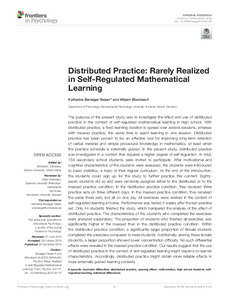| dc.date.accessioned | 2019-02-04T14:40:08Z | |
| dc.date.available | 2019-02-04T14:40:08Z | |
| dc.date.issued | 2018-11-20 | |
| dc.identifier | doi:10.17170/kobra-20190204143 | |
| dc.identifier.uri | http://hdl.handle.net/123456789/11056 | |
| dc.description.sponsorship | Gefördert durch den Publikationsfonds der Universität Kassel | |
| dc.language.iso | eng | |
| dc.rights | Urheberrechtlich geschützt | |
| dc.rights.uri | https://rightsstatements.org/page/InC/1.0/ | |
| dc.subject | desirable difficulties | eng |
| dc.subject | distributed practice | eng |
| dc.subject | spacing effect | eng |
| dc.subject | mathematics | eng |
| dc.subject | high school students | eng |
| dc.subject | self-regulated learning | eng |
| dc.subject | individual differences | eng |
| dc.subject.ddc | 150 | |
| dc.title | Distributed Practice: Rarely Realized in Self-Regulated Mathematical Learning | eng |
| dc.type | Aufsatz | |
| dcterms.abstract | The purpose of the present study was to investigate the effect and use of distributed practice in the context of self-regulated mathematical learning in high school. With distributed practice, a fixed learning duration is spread over several sessions, whereas with massed practice, the same time is spent learning in one session. Distributed practice has been proven to be an effective tool for improving long-term retention of verbal material and simple procedural knowledge in mathematics, at least when the practice schedule is externally guided. In the present study, distributed practice was investigated in a context that required a higher degree of self-regulation. In total, 158 secondary school students were invited to participate. After motivational and cognitive characteristics of the students were assessed, the students were introduced to basic statistics, a topic of their regular curriculum. At the end of the introduction, the students could sign up for the study to further practice this content. Eighty-seven students did so and were randomly assigned either to the distributed or to the massed practice condition. In the distributed practice condition, they received three practice sets on three different days. In the massed practice condition, they received the same three sets, but all on one day. All exercises were worked in the context of self-regulated learning at home. Performance was tested 2 weeks after the last practice set. Only 44 students finished the study, which hampered the analysis of the effect of distributed practice. The characteristics of the students who completed the exercises were analyzed exploratory: The proportion of students who finished all exercises was significantly higher in the massed than in the distributed practice condition. Within the distributed practice condition, a significantly larger proportion of female students completed the exercises compared to male students. Additionally, among these female students, a larger proportion showed lower concentration difficulty. No such differential effects were revealed in the massed practice condition. Our results suggest that the use of distributed practice in the context of self-regulated learning might depend on learner characteristics. Accordingly, distributed practice might obtain more reliable effects in more externally guided learning contexts. | eng |
| dcterms.accessRights | open access | |
| dcterms.creator | Barzagar Nazari, Katharina | |
| dcterms.creator | Ebersbach, Mirjam | |
| dc.relation.doi | doi:10.3389/fpsyg.2018.02170 | |
| dc.type.version | publishedVersion | |
| dcterms.source.identifier | EISSN: 1664-1078 | |
| dcterms.source.journal | Frontiers in Psychology | |
| dcterms.source.pageinfo | 2170 | |
| dcterms.source.volume | 2018, 9 | |

